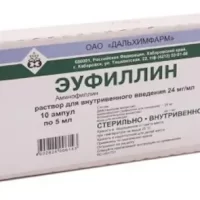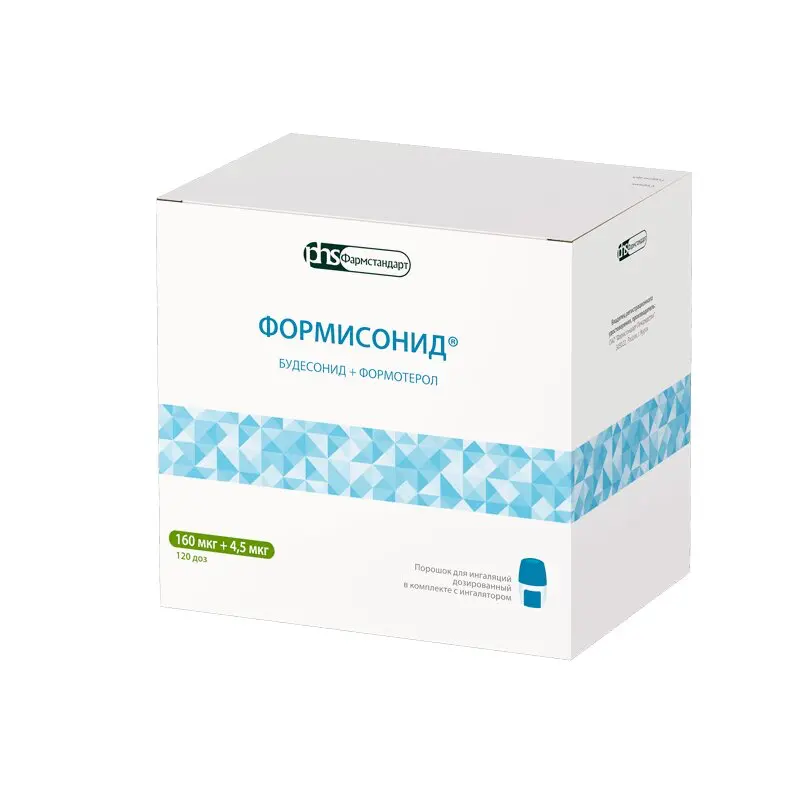Description
Salticasone Pharmacodynamics
Saltikazone® is a combined preparation containing two active components: salmeterol xynaphoate and fluticasone propionate, which have different mechanisms of action. Salmeterol prevents the occurrence of bronchospasm symptoms, while fluticasone improves pulmonary function and prevents exacerbation. Salmeterol®, due to its convenient dosing regimen, may be an alternative for patients who simultaneously receive a beta2-adrenoreceptor agonist and an inhaled glucocorticosteroid (GCS) using different inhalers.
Salmeterol is a selective long-acting (up to 12 hours) beta2-adrenoreceptor agonist that has a long side chain in its structure that binds to the outer domain of the receptor.
The pharmacological properties of salmeterol provide protection against histamine-induced bronchoconstriction and longer bronchodilation (lasting at least 12 hours) than short-acting beta2-adrenoreceptor agonists.
Salmeterol is a strong and long-acting inhibitor of the release from human lung tissue of mast cell mediators such as histamine, leukotrienes, and prostaglandin D2.
Salmeterol inhibits the early and late phases of response to inhaled allergens. Inhibition of the late phase of the response persists for more than 30 hours after a single dose, at a time when the bronchodilator effect is no longer present. A single dose of salmeterol attenuates bronchial hyperresponsiveness. This indicates that salmeterol, in addition to its bronchodilator activity, has an additional action unrelated to bronchial dilation, the clinical significance of which has not been definitively established. This mechanism of action is different from the anti-inflammatory effect of GCS.
Fluticasone belongs to the group of GCS for local use and when administered by inhalation in recommended doses, it has a pronounced anti-inflammatory and anti-allergic effect in the lungs, which leads to a reduction of clinical symptoms, reducing the frequency of exacerbations of bronchial asthma. Fluticasone does not cause adverse effects that are observed with systemic administration of glucocorticosteroids.
During long-term use of inhaled fluticasone, daily secretion of adrenal cortical hormones remains within normal limits in both adults and children, even when maximum recommended doses are used. After switching patients receiving other inhaled GCSs to fluticasone, daily adrenal hormone secretion has gradually improved despite prior and current intermittent use of oral GCSs. This indicates the recovery of adrenal function against the background of inhaled fluticasone use. With prolonged use of fluticasone, adrenal cortical reserve function also remains within normal limits, as evidenced by a normal increase in cortisol production in response to appropriate stimulation (note that residual decrease in adrenal reserve caused by previous therapy may persist for a long time).
Indications
Saltikazone® is indicated for the routine treatment of bronchial asthma if combined therapy with a long-acting beta2-adrenomimetic and an inhaled glucocorticosteroid is indicated:
– Patients with inadequate disease control on continuous monotherapy with inhaled glucocorticosteroids with intermittent use of a short-acting beta2-adrenomimetic;
– patients with adequate disease control against the background of therapy with inhaled glucocorticosteroid and long-acting beta2-adrenomimetic;
– as initial maintenance therapy in patients with persistent bronchial asthma in presence of indications to prescribe glucocorticosteroids for achievement of disease control.
Saltikazone® is intended for maintenance therapy in COPD in patients with a forced expiratory volume (FEF1) < 60% of proper values (before inhalation of a bronchodilator) and recurrent exacerbations in the history, in which severe symptoms persist despite regular therapy with bronchodilators.
Contraindications
– Hypersensitivity to the components of the drug.
– Childhood under 4 years of age.
– Childhood under 18 years of age (for the drug intended for use with the multi-dose inhaler “OstreaHaler”, because there is no clinical experience of using this device in children).
Caution
As with all other inhaled agents containing GCS, Saltikazone® should be used with caution in patients with acute or latent pulmonary tuberculosis.
Saltikasone® should be used with caution in thyrotoxicosis, fungal, viral or bacterial infections of the respiratory system.
When taking any drugs of the group of sympathomimetics, especially when therapeutic doses are exceeded, cardiovascular events such as increased systolic blood pressure and heart rate may occur. For this reason, Saltikazone® should be used with caution in patients with cardiovascular diseases (coronary heart disease (CHD), idiopathic hypertrophic subaortic stenosis, uncontrolled arterial hypertension, QT interval prolongation on ECG), including arrhythmias such as supraventricular tachycardia and extrasystole, ventricular extrasystole, atrial fibrillation.
Saltikazone® should be used with caution in patients with hypokalemia, because all sympathomimetic drugs in doses higher than the therapeutic ones may cause transient decrease of plasma potassium (K+) concentration.
Saltikazone® should be used with caution in persons with a history of allergic reactions to lactose and milk protein (residual protein may be part of lactose), because partial swallowing of the drug during inhalation is possible (the drug contains lactose).
Any inhaled GCS may cause systemic effects, especially when used in high doses for a long time. Therefore, the drug should be used with caution in glaucoma, cataract, osteoporosis.
There are very rare reports of increased blood glucose concentration, therefore, patients with diabetes mellitus should use Saltikazone® with caution.
– Hypersensitivity to the components of the drug.
– Childhood under 4 years of age.
– Childhood under 18 years of age (for the drug intended for use with the multi-dose inhaler “OstreaHaler”, because there is no clinical experience of using this device in children).
Caution
As with all other inhaled agents containing GCS, Saltikazone® should be used with caution in patients with acute or latent pulmonary tuberculosis.
Saltikasone® should be used with caution in thyrotoxicosis, fungal, viral or bacterial infections of the respiratory system.
When taking any drugs of the group of sympathomimetics, especially when therapeutic doses are exceeded, cardiovascular events such as increased systolic blood pressure and heart rate may occur. For this reason, Saltikazone® should be used with caution in patients with cardiovascular diseases (coronary heart disease (CHD), idiopathic hypertrophic subaortic stenosis, uncontrolled arterial hypertension, QT interval prolongation on ECG), including arrhythmias such as supraventricular tachycardia and extrasystole, ventricular extrasystole, atrial fibrillation.
Saltikazone® should be used with caution in patients with hypokalemia, because all sympathomimetic drugs in doses higher than the therapeutic ones may cause transient decrease of plasma potassium (K+) concentration.
Saltikazone® should be used with caution in persons with a history of allergic reactions to lactose and milk protein (residual protein may be part of lactose), because partial swallowing of the drug during inhalation is possible (the drug contains lactose).
Any inhaled GCS may cause systemic effects, especially when used in high doses for a long time. Therefore, the drug should be used with caution in glaucoma, cataract, osteoporosis.
There are very rare reports of increased blood glucose concentration, therefore, patients with diabetes mellitus should use Saltikazone® with caution.
How to use and dosages
- Salticasone® is indicated only for inhalation with Inhaler CDM® inhaler in adults and children aged from 4 to 18 years or with multi-dose inhaler “OstreaHaler” in adults.
- The patient should be informed that for optimal effect, the drug should be used regularly, even in the absence of clinical symptoms of bronchial asthma and COPD.
- The physician should regularly evaluate the patient’s treatment efficacy.
- Determining the duration of therapy and changing the dose of the drug is possible only on the doctor’s recommendation.
- Bronchial asthma
- The dose of Saltikasone® should be reduced to the lowest dose ensuring effective control of symptoms.
- If administration of Saltikasone® 2 times a day provides control of symptoms, within the framework of dose reduction to the lowest effective dose, it is possible to reduce the frequency of drug administration to once a day.
- The patient should be prescribed a dose of Saltikasone® that contains the dose of fluticasone appropriate for the severity of his disease.
- If therapy with inhaled GCS does not provide adequate control of the disease, their replacement with Saltikasone® in a dose therapeutically equivalent to the dose of administered GCS may improve the control of bronchial asthma. In patients whose bronchial asthma can be controlled solely with inhaled GCS, their replacement with Saltikasone® may allow to reduce the dose of GCS necessary to control the disease course.
- Recommended doses.
- Adults and children 12 years of age and older
- One inhalation (50 µg salmeterol and 100 µg fluticasone propionate) 2 times daily,
- or one inhalation (50 µg salmeterol and 250 µg fluticasone propionate) 2 times daily, or one inhalation (50 µg salmeterol and 500 µg fluticasone propionate) 2 times daily.
- In adults, doubling the dose while using any dosage of Salticasone® for 14 days maintains the same safety and tolerability as with regular use of the drug in one inhalation twice a day. Doubling of the dose is possible in cases when patients require additional short-term (up to 14 days) therapy with inhaled corticosteroids.
- Children 4 years and older
- One inhalation (50 µg salmeterol and 100 µg fluticasone propionate) 2 times daily.
- In the pediatric population (ages 4 to 18 years), Salticasone® may be used only with the Inhaler CDM® inhaler. The use of multi-dose inhaler “OstreaHaler” in children is not recommended because there is no experience of its clinical use in pediatric population.
- Chronic obstructive pulmonary disease (COPD)
- Recommended doses
- For adult patients, the maximum recommended dose is 1 inhalation (50 mcg salmeterol and 500 mcg fluticasone) 2 times a day.
- Special patient groups
- There is no need to reduce the dose of Salticasone® in elderly patients as well as in patients with renal or hepatic impairment.
- Instructions for inhalation
- Salticasone® in the form of a metered-dose inhalation powder is administered only with the CDM® Inhaler or the OstreaHaler multi-dose inhaler.
- Instructions for use of the CDM® Inhaler
- The Inhaler CDM® powder inhaler is a plastic device with a movable top and a retractable capsule compartment, about 6 cm high.
- The capsules are for inhalation use only and are not intended to be swallowed.
- The capsule should be taken out of the cell pack immediately prior to use.
- “Inhaler CDM® is a single-dose inhaler that allows you to dose and inhale the drug in very small doses. Salticasone® enters the patient’s airway with air currents when actively inhaled through the mouthpiece.

![Salmeterol, fluticasone (Salticasone) inhalation 50 mcg + 50 mcg - [60 doses]](https://mediscom.com.co/wp-content/uploads/2025/06/Salticasone-50mkg250mkg-60.webp)

![Formoterol powder for inhalation 12 mcg - [60 capsules]](https://mediscom.com.co/wp-content/uploads/2025/06/Formoterol-12mkg-60-200x200.webp)

![Ectalust (Montelukast) 4 mg [28 tablets]](https://mediscom.com.co/wp-content/uploads/2025/06/Ectalust-4mg-28-200x200.webp)